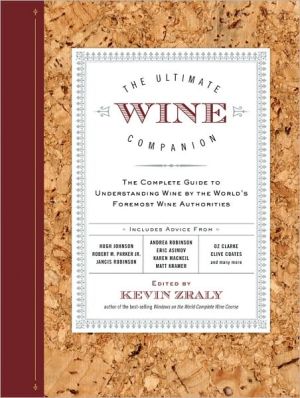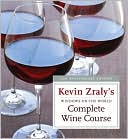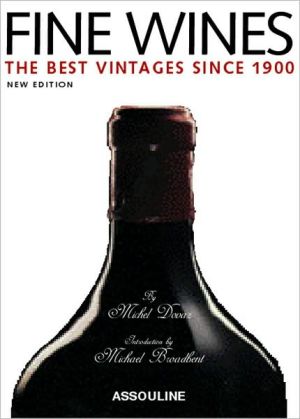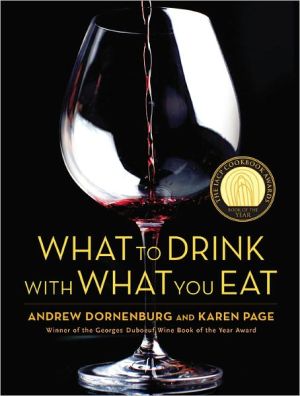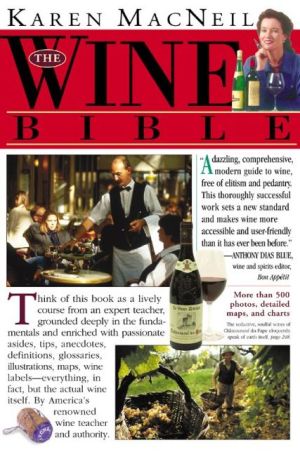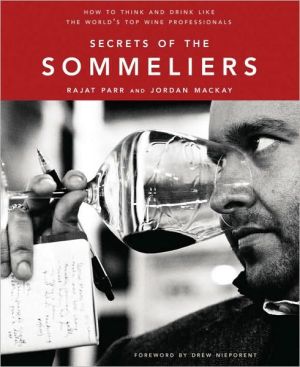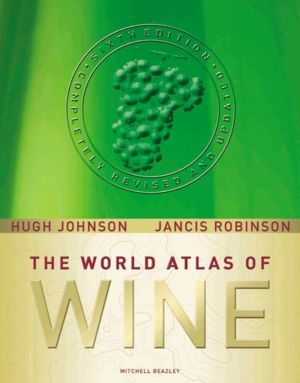Accidental Connoisseur: An Irreverent Journey Through the Wine World
What is taste? Is it individual or imposed on us from the outside? Why are so many of us so intimidated when presented with the wine list at a restaurant? In The Accidental Connoisseur, journalist Lawrence Osborne takes off on a personal voyage through a little-known world in pursuit of some answers. Weaving together a fantastic cast of eccentrics and obsessives, industry magnates and small farmers, the author explores the way technological change, opinionated critics, consumer trends,...
Search in google:
What is taste? Is it individual or imposed on us from the outside? Why are so many of us so intimidated when presented with the wine list at a restaurant? In The Accidental Connoisseur, journalist Lawrence Osborne takes off on a personal voyage through a little-known world in pursuit of some answers. Weaving together a fantastic cast of eccentrics and obsessives, industry magnates and small farmers, the author explores the way technological change, opinionated critics, consumer trends, wheelers and dealers, trade wars, and mass market tastes have made the elixir we drink today entirely different from the wine drunk by our grandparents.In his search for wine that is a true expression of the place that produced it, Osborne takes the reader from the high-tech present to the primitive past. From a lavish lunch with wine tsar Robert Mondavi to the cellars of Marquis Piero Antinori in Florence, from the tasting rooms of Chateau Lafite to the humble vineyards of northern Lazio, Osborne winds his way through Renaissance palaces, $27 million wineries, tin shacks and garages, opulent restaurants, world-famous chais and vineyards, renowned villages and obscure landscapes, as well as the great cities which are the temples of wine consumption: New York, San Francisco, Paris, Florence, and Rome. On the way, we will be shown the vast tapestry of this much-desired, little-understood drink: who produces it and why, who consumes it, who critiques it? Enchanting, delightful, entertaining, and, above all, down to earth, this is a wine book like no other. The New York Times The Accidental Connoisseur is a vital book for those who care about wine; who find hyperventilated discussions of microscopic differences between hundreds of essentially identical wines to be little more than scholastic quibbling about how many angels can dance on the top of a cork; who see the quasi religion that raises wine to the status of a Holy Grail promising ineffable pleasure to be in reality a mercenary and joyless cult, which stuffs the mad delights of Dionysus into a neo-Puritan brown bag. Osborne is a new voice in the wine world, smart, generous, perceptive, funny, sensible, free of cant and arrogance and self-interest. It's about time. ''Great Wine Writing'' just got a good deal thicker. — Peter Singer
Introduction: A Matter of TasteMan’s tongue, on the other hand, by the delicacy of its surfaces and of the various membranes which surround it, proves clearly enough the sublimity of the operations for which it is destined.\ —Jean Anthelme Brillat-Savarin I grew up in Britain in the 1970s, before wine became fashionable. Drinking it has therefore never been second nature to me. Like most Catholic children, my first memory of wine is on the altar, and it was always a game to see how much of the sacrament you could gulp down when it was your turn to taste Our Lord’s hemoglobin. It was sour, its dim taste mixed up with sickly sensations: the greasy fingers of our priests, cheap pewter goblets, and chewy, bready, polystyrenelike wafers.\ I now think this sacred wine was a cheaper Sainsbury’s Beaujolais, an economical option in the 1970s retailing for about three dollars a bottle, because with its taste of sour raspberries came also a ghostly scent of ripe bananas, which I have ever after associated with Our Lord’s unfortunate decomposition on the Cross.\ To many in Britain, wine was exotic, especially in the puritanical small commuter town of Haywards Heath where I grew up just south of London. In those days the dominant British chain wine store was Unwin’s, and the Haywards Heath Unwin’s was a place to buy crates of Smirnoff and dark blue bottles of Liebfraumilch, but almost nothing else, aside from those three-dollar bottles of Beaujolais. All drinks came under the Arabic word alcohol, essentially reducing them to the level of a chemical sin, and none of them could be bought on Sunday.\ The wine store with its windows stuffed with loopy bottles of Mateus rosé in straw flasks was a place of vague iniquity, a place where immigrant Iberian bricklayers perhaps slaked their addictions in secret. In our house, wine was never drunk. Sunday lunch came with sherry and reconstituted fruit drinks, but never a wine. Even the word “wine” struck a strained note in many English gatherings.\ This alienation left an inevitable mark. For me, as for most English speakers, wine became a consumer interest, but not an instinctual one. I have always been haunted by the same question: Do I really know what I’m drinking and why? For that matter, how do I know that my own tastes are authentic? Wine is a dangerous game. Wherefore a sinister little hunch always creeps into my mind as I am drinking it: I do not trust my own taste.\ Few things make us more insecure about taste than wine. Some seventy-five thousand different wines made in the world today sustain a $50 billion industry, but there are only a handful of real wine experts to help us sort them out. The language of their expertise may convince us on the page, but only adds to our confusion when we actually taste wine. Their encyclopedias tell us what we’re supposed to taste, but never how each of us can appropriate the experience for ourselves. Taste is what defines our personality, but it’s as solid as a soap bubble.\ What, then, is taste? We secretly pride ourselves on our taste. Yet nothing is more terrifying to contemplate. And no taste is more awkward to contemplate than taste in wine. Wine is the ultimate exercise in this mysterious skill, this nuanced zone of pleasure. Nothing requires more taste than wine. For the greatest wines will provoke the most complex physiological reactions of any foodstuff.\ Wine is now one of the dominant consumer fetishes of the Western world, with its own hyperventilating journalistic industry. One is bombarded with wine talk on all sides. Aimé Guibert, the noted French wine maker, has said: “For millennia wine was the center of Western civilization. It has always been a mystery. Today it has been transformed into a commodity.”\ Wine guides, those irrefutable encyclopedias of taste, are ubiquitous. From Robert Parker’s Wine Enthusiast and Wine Buyer’s Guide, to Frank Schoonmaker’s 1964 Encyclopedia of Wine, to the works of the nineteenth-century connoisseur George Saintsbury and the twentieth-century one Gerald Asher, to Alexis Lichine’s classic Encyclopedia of Wines and Spirits and the Larousse Encyclopedia of Wine. So many encyclopedias, so little time!\ But there is the rub. Taste is not learned out of books; it is not given from one person to another. Therein lies its profundity. At school, fatuous masters would say of poems they didn’t like, using the old Latin saw, De gustibus non disputandum est—there’s no accounting for taste. And so there isn’t. Taste is like a perverse coral: it grows slowly and inexorably into unpredictable shapes, precisely because it’s an offshoot of living itself. Acquiring taste, then, is not a result of study; it’s a talent for living life.\ A distrust of our own taste is what defines us as what could be called accidental drinkers. And the more I have tried to make my little steps toward accidental connoisseurship, the more I have made a fool of myself.\ I once happened to be sitting alone in the restaurant called Le Verger des Papes just underneath the ruined castle of Châteauneuf-du-Pape in the southern Rhône, in the heart of a world-famous wine country. The place was deserted except for a thin professorial type at the neighboring table eating a salad. The waiter came and asked me what I wanted to drink. I scanned the list and didn’t recognize a single thing, an extraordinary feat since the list contained just about every popularly known Châteauneuf-du-Pape there is. My eye caught the name Beaucastel: the most expensive item on the list. I ordered it.\ Halfway through the Beaucastel, which cost twice as much as the whole meal, I thought I should engage in some small wine talk with the waiter. We bantered about Beaucastel. Neither of us knew anything about it, but the waiter offered some opinions which he had probably read in the newspaper.\ “Don’t you find,” he said, “that there’s a funny taste of chicken coops in Rhône wines? Especially Beaucastel.”\ “Chicken coops?” Was he pulling my leg?\ “Even the great wines, you know, have a whiff of chicken coops. It’s well known.”\ I offered him a glass of the Beaucastel. I tasted it again, now frantically looking for traces of sublimated chicken coops. The waiter winked at me: was he suggesting I’d been had?\ “Taste it?” he said. “A bit poopy, eh?”\ “Well,” I said, “maybe I can taste chicken coops.”\ I couldn’t taste anything of the sort. But we swirled and sipped and agreed that the chicken-coop element gave the wine its complexity.\ At this moment, the man next to us suddenly came to life, sat up erect, and said, “Brettanomyces!” He drawled this extraordinary word, suspending his fork in midair and sending us a wan smile.\ “Excuse me?”\ “Brettanomyces.” I saw that his nose was quite red and that he was possibly even drunker than I. “Brett,” he went on. “It’s a yeast. That chicken-coop taste comes from a yeast called brett. Brett is everywhere in Rhône wines. Especially Beaucastel.”\ “It’s very good,” I said stupidly.\ He and the waiter laughed.\ “I can see, monsieur,” the tipsy professor said, “that you are a man of taste. Men of taste, monsieur, are few and far between.” The irony seeped delicately through his sentences and he wiped his mustache with a napkin as I poured him a glass as well. “Well,” he said, “here’s to chicken coops!”\ The word “taste” comes from the Old French taster, “to feel,” whose medieval English equivalent was tasten. The French word itself descended from the Latin taxare, “to evaluate, handle.”\ Ultimately, all these words derive from the Latin tangere, “to touch.” In the sense of “aesthetic judgment,” however, “taste” only arrived in English in 1674, and the term “tasteful” dates only from 1756. Our conventional notion of “taste” is essentially an eighteenth-century invention.\ The eighteenth century was obsessed with taste. It became the greatest of all bourgeois fads, and dozens of treatises on taste duly appeared, almost none of them readable. The most famous of them all was Dr. Jean Anthelme Brillat-Savarin’s Physiology of Taste, published in Paris in 1826. Many regard it as the gastronomic Bible; others think it’s as overrated as Casanova’s memoirs. But does it tell us anything about taste?\ The doctor begins by admitting that it’s a tough subject. “It is not easy,” he concedes glumly, “to determine precisely what parts make up the organ of taste. It is more complicated than it seems.”\ Taste, he theorizes, is divided into three classes (eighteenth-century theorists nearly always divide everything into threes):\ In physical man it is the apparatus by which he distinguishes various flavours. In moral man it is the sensation which stimulates that organ in the center of his feeling which is influenced by any savorous body. Lastly, in its own material significance, taste is the property possessed by any given substance which can influence the organ and give birth to sensation.\ It was clear to Brillat-Savarin that the tongue was the central muscle of taste. But he also observed that people deprived of that subtle organ could still taste, in a manner. In Amsterdam, he had met an errand runner whose tongue had been cut out by Algerian slave dealers. Communicating by means of little written notes, the doctor and the lingual amputee carried on a lively discussion about taste. The errand boy could still taste things, though swallowing was a torture. Even so, the doctor concludes that all tongues are not created equal. And even though, as he says, “the space between something called good and something reputed to be excellent is not very great,” some tongues are endowed with more taste buds than others.\ Overall, Brillat-Savarin says, the human tongue is the glory of creation. It proves the “supremacy of man.” Faced with the phrenologist Dr. Gall’s contention that some animals might have better tongues than we have, Brillat-Savarin erupts: “This doctrine is shocking to hear and smacks of heresy.”\ He points out that the human tongue is capable of amazing feats. Roman gourmands could tell if a fish had been caught between the city bridges or lower down the Tiber; French palates could easily detect the special flavor of the leg a pheasant leans on when it rests. And wine appreciation was a case unto itself. All this, Brillat-Savarin concludes, proves that “man must be proclaimed the great gourmand of Nature.” The human tongue, moreover, has no equivalent in the animal world.\ But do wine tasters have tongues even more masterly than those of the human species in general? Robert Parker, the all-powerful American critic, has hinted that such is the case with his tongue. He has argued in the same vein as Brillat-Savarin that some tongues—such as his own—have more papillae than others.\ However, the human tongue doesn’t vary from individual to individual; its anatomical structures are constant. No biologist could tell you how the tongue of Robert Parker differs from, say, the fearsome organ of Joey Buttafuoco. Taste, it seems, is biologically universal.\ Anatomically, a taste bud consists of about twenty long, slender cells, with a tiny hair projecting from each cell to the surface of the tongue through a pore. Taste cells contain nerve filaments that convey impulses to the taste center in the brain. For all the subtleties which human taste is capable of, these buds themselves can only taste four elementary things: sweetness, sourness, saltiness, and bitterness. Curiously, only the buds most sensitive to salty flavor are scattered evenly over the tongue. Sweet-sensitive taste buds are concentrated on the tip of the tongue, sour flavors are detected at the sides of the tongue, and bitter flavors at the back.\ There is now a whole branch of scientific research known as taste hedonics. For a while, this seemed to be a promising avenue of inquiry, especially as scientists are fascinated as to why animals like sweet things. Is my tongue like that of a cow? An anteater? Do I lick fruit like a chimpanzee? Yet in the end, such questions are quixotic. To discover my own tastes in wine, I would have to discard both books and science, and go into the world of wine and drink. For despite its biological universality, taste has no subjective truth that can be measured, no essence—as Susan Sontag once remarked, it “has no system and no proofs.” It can only be developed by action, which is to say by pleasure itself.
\ From the Publisher"Funny, provocative, and vastly entertaining." —Gerald Asher\ "A humorous punch in the nose to wine snobs who think money buys good taste." —Kermit Lynch\ "Lawrence Osborne's The Accidental Connoisseur is shrewd, apt, acerbic and often quite crazy. We are carried along equally by the honed criticism and the fine writing." — Jim Harrison\ \ \ \ \ \ The New York TimesThe Accidental Connoisseur is a vital book for those who care about wine; who find hyperventilated discussions of microscopic differences between hundreds of essentially identical wines to be little more than scholastic quibbling about how many angels can dance on the top of a cork; who see the quasi religion that raises wine to the status of a Holy Grail promising ineffable pleasure to be in reality a mercenary and joyless cult, which stuffs the mad delights of Dionysus into a neo-Puritan brown bag. Osborne is a new voice in the wine world, smart, generous, perceptive, funny, sensible, free of cant and arrogance and self-interest. It's about time. ''Great Wine Writing'' just got a good deal thicker. — Peter Singer\ \ \ Publishers WeeklyThe number of serious wine books published in recent years can be counted on one hand-which makes Osborne's funny and erudite tale all the more welcome. Structured as a traditional quest, it stems from an insecurity of the author's English childhood: "I do not trust my own taste." So he embarks, Quixote-like, on 11 adventures in the wine world, jetting from France to California, then Italy, hoping to plumb the mystery of why someone would spend $600 on a bottle of fermented grape juice. At every step, Osborne, who's written for the New York Times Magazine, Lingua Franca and other publications, trains his reporter's eye-previously honed in books like American Normal-on both the big picture and telling details. At a comical lunch with viniculture icon Robert Mondavi, Osborne swiftly gets at the importance of his contribution to the industry, while also squeezing in the apt observation that Mondavi's wife, Margrit, reminds him of German filmmaker Leni Riefenstahl, "at once coquettish and dominant." Despite the miles logged, Osborne's journey is primarily an intellectual one, and his writing will be appreciated by high-minded readers: "Wine is always the lightning conductor of an irrepressible and often iniquitous cosmopolitanism." By the last chapter, Osborne can't say exactly what Chateau Lafite Rothschild tasted like, and he has just encountered the foulest bottle of his life. But he also sounds strangely contented, because he's found the rare world where aesthetics still matter-even if the terminology and the people who employ it can be maddening. (Mar.) Copyright 2004 Reed Business Information.\ \ \ \ \ Library JournalLike many people, freelance journalist Osborne (American Normal: The Hidden World of Asperger Syndrome) lacks confidence in his ability to assess the varied characteristics of wine. Accordingly, he set out to explore these mysteries and records his findings here. His odyssey takes him from Italy to California to France and back, interviewing vintners as diverse as Robert Mondavi of Napa and independent winemaker Pierre Siri of Bordeaux. He learns that wine should have layers of flavor (often detectable only by super-sensitive palates); terroir, with flavors echoing the soil that produced the grapes; and intensity and subtlety. In the end, it also comes down to a bit of serendipity. Osborne's flowery writing style demands patient readers and detracts from his findings. His real strength lies in the passionate discussions with winemakers and growers. An additional purchase for larger public libraries.-Andrea Dietze, Orange Cty. P.L., Santa Ana, CA Copyright 2004 Reed Business Information.\ \ \ \ \ Kirkus ReviewsA wide-ranging journalist/author takes to the oenophile road. "Is there anything better than drinking?" Osborne (The Poisoned Embrace, 1993, etc.) asks. "When the happiness of drinking overwhelms you, you cannot resist it." But Osborne felt terribly self-conscious about drinking wine, wondering whether his choices were the promptings of others or the authentic response of his tongue to something good. Wanting to feel comfortable with his likes and dislikes, to breathe free of the floodtide of wine opinion, off he went to California, France, and Italy to educate himself. That meant, in measure, coming to know himself, as well as something about what the winemaker was after. He had to dig into the notions of taste and the realities of terroir, into hugeness versus finesse, into the usable nuggets of prejudiced wisdom from the wine police threshed from the ego and dross. By temperament, Osborne is drawn to the stranger byways and backrooms of winemaking; he's not about to pass up a sampling from Angelo Gaja or lunch with Robert Mondavi (though both had him sweating his self-confidence), but he's happier in the company of California garagiste Bill Cadman, a man of "dark forces, mistakes, passions, and truculent convictions," or bad-boy alchemist Randall Grahm. Like Kermit Lynch and Simon Loftus, Osborne is looking for a connection between grape, place, and himself, a trifecta that, with growing exposure to ideas, intentions, and product, he hits more often than he would at the racetrack. His prose has a pleasing, gentle flow, with eddies of humor and yeastiness; Osborne displays a hungry mind, and a gift for taking in the landscape even if he dislikes the wine: "a distant field of mustardswitching off for the night," or "cypresses stabbing into the dark blue air . . . silhouettes of umbrella pines along the hills." He takes the showboats down a peg, but he isn't a self-conscious iconoclast, just an odd fellow looking for a mouthful of happiness. Personable and keen-minded.\ \

